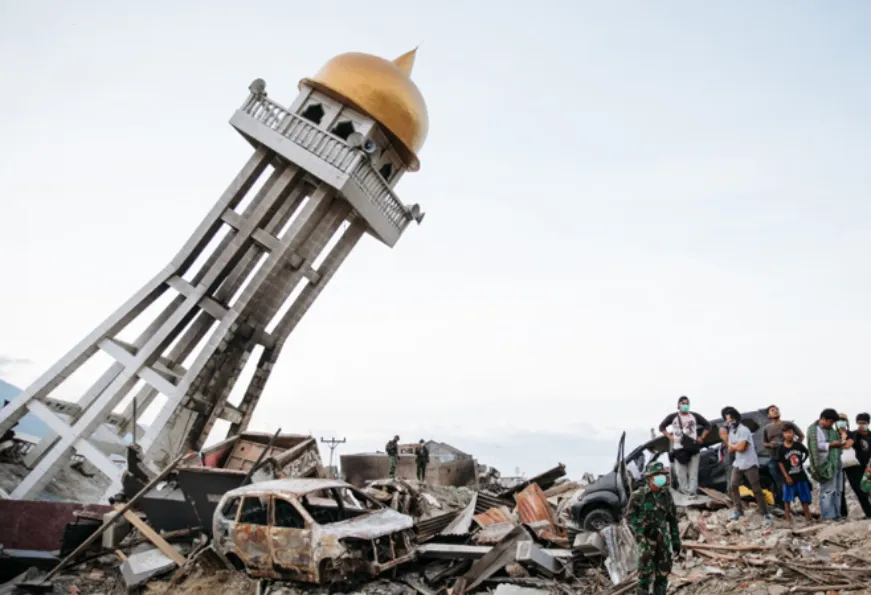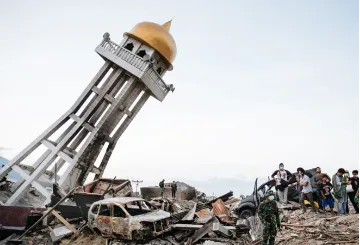
Understanding risk profile and resilience management
Indonesia has a high disaster risk profile, as assessed by relevant institutions such as The European Commission Disaster Risk Management Knowledge Centre, Asian Development Bank (ADB), the World Bank, and EM-DAT of The Centre for Research on the Epidemiology of Disasters (CRED). Bappenas (2021) estimated that Indonesia will suffer a loss of approximately IDR544 trillion during 2020–2024 from climate-change effects without adaptation efforts. It also demonstrated that spontaneous adaptation measures—relating to sector-specific adaptation initiatives—can reduce the losses up to IDR95.7 trillion or 15 percent. If planned climate-resilience development initiatives are implemented, the losses could be reduced to IDR58.3 trillion or almost 50 percent.
The response to disaster risks varies depending on the stage of the situation. In general, risk management is divided into three stages: pre-disaster, disaster/emergency event, and post-disaster. Pre-disaster efforts include adaptation to current or anticipated future climate conditions, reduction of negative impacts, capitalisation on potential benefits; and mitigation to slow climate change. Meanwhile, rapid response to the disaster situation necessitates the deployment of rescue teams and emergency assistance. Recovery and rehabilitation measures to help victims reconstruct their lives, including the repair of public and housing amenities, are standard post-disaster programmes. All three stages require massive resources, namely manpower, funds, and technology.
[pullquote]Recovery and rehabilitation measures to help victims reconstruct their lives, including the repair of public and housing amenities, are standard post-disaster programmes.[/pullquote]
Financing the efforts for disaster resilience is challenging. Even though individuals and policymakers recognise that natural dangers are increasing, losses can escalate, and recovery costs are extremely high, raising funds before a catastrophe event occurs is a lower priority than rapid response to disaster events. While we cannot completely avoid disasters, we can reduce the severity of their effects by enhancing preparedness in the pre-disaster stage. Less severe damages will save funds used to respond to and recover from the disasters. This suggests that disaster risk management requires coordinated efforts at all stages of the disaster (pre-event, event response, and post-disaster recovery).
Efficient strategic financing
Direct disaster funding is provided through reserve or contingency money, whereas indirect disaster financing is provided through insurance or investment for prevention. Typically, policy measures tend to prioritise emergency finances, with relatively less emphasis placed on the integration of insurance and mitigation strategies as integral components of a comprehensive disaster management policy. Investing in climate-resilient infrastructure, for example, is given less attention in disaster management policy.
Indonesia has made significant strides in bolstering its capacity to mitigate the risks associated with frequent natural disasters. This has been achieved via the implementation of a range of policies, with particular emphasis on fiscal measures and institutional frameworks. The government launched the Disaster Risk Financing and Insurance Strategy (DRFI) in 2018 with the goal of improving disaster management capacities and increasing economic resilience in the face of calamities. The DRFI instrument, known as the Disaster Pooling Fund (DPF), works in tandem with the state budget. The World Bank has committed to disbursing a US$500-million loan package through the “Indonesia Disaster Risk Finance and Insurance” initiative to fund the DPF from March 2021 to March 2024. The Global Risk Financing Facility (GRiF) has also contributed US$14 million to this loan. Furthermore, Indonesia is nearing completion of the Adaptive Social Protection (ASP) Roadmap, which integrates climate change adaptation and catastrophe risk management into the social protection system. While DPF has been in operation since 2021, the DRFI roadmap has yet to be fully implemented.
[pullquote]The government launched the Disaster Risk Financing and Insurance Strategy (DRFI) in 2018 with the goal of improving disaster management capacities and increasing economic resilience in the face of calamities.[/pullquote]
The payment of insurance premiums necessitates a comparatively modest allocation of capital, often ranging from 0.04 percent to 0.2 percent of the aggregate value of the insured assets. However, for a large and disaster-prone country like Indonesia, the number of catastrophic insurance and re-insurance companies in the market to cover the bulk of disaster risks is insufficient. Furthermore, disasters destroy not only typical insured assets but also public facilities (roads, rail lines, power grid, and so on) that may not be insurable, disrupt socioeconomic activities (revenue losses and traumatic experience), and divert national resources for lengthy recovery efforts. As a result, developing the insurance and reinsurance markets for disaster hedging is vital but insufficient. This means that the country requires a large and long-term disaster pooling fund to manage disaster risks.
To improve finance efficiency, the government can categorise disaster finance based on its distinctive qualities: (i) A future catastrophic fund characterized by a substantial monetary value and low annual spending, (ii) The provision of co-financing for pre-disaster activities: preparedness fund, mitigation and adaptation funds; (iii) Co-financing for disaster response: emergency fund; and (iv) Co-financing for post-disaster programmes—insurance and social protection.
Mobilisation strategy for financial resources
The DPF’s principal fiscal resources are the state budget, subnational budget, and other permitted sources such as insurance compensation, investment returns, grants, collaboration, and trust funds, per Presidential Regulation No. 75 of 2021. State budgets allocated US$1.54 billion in catastrophic contingency funding from 2016 to 2019. Additionally, the National Agency for Disaster Management’s (BNPB) yearly budget allocation is US$1.38 billion for the 2016-2019 timeframe. The amount is insufficient for effective resilience management.
The following solutions for fund mobilisation can be established based on financing characteristics: (i) soft loans, catastrophic bonds (Cat bond), and specific allocation from the state budget for large future catastrophic fund. (ii) BNPB allocates preparedness funds, while climate funds are coordinated with mitigation and adaptation expenditures; and (iii) partnerships with both national and foreign catastrophic insurance companies and institutions and allocating additional state budget for BPJS dedicated to post-disaster poverty and health protections.
[pullquote]Indonesia could work with international cat bond issuers or multilateral agencies to strategically structure the bond in such a way that the risk probability and premium are reduced.[/pullquote]
The following is a more detailed explanation of the recommended strategy:
A long-term disaster fund should target positive net returns. Thus, this fund needs competent fund management. Loans, bonds, and concession loans can help fill the funding gap if the returns on investment, including economic benefits, exceed the borrowing costs. This simple rule should serve as a guideline.
Indonesia has not issued Cat bonds, making it worth investigating. For disaster-financing insurance and reinsurance companies, Cat bonds as insurance-linked security is appealing. Global empirical evidence shows that well-managed catastrophe bonds like Swiss Re’s outperform the stocks market.
Depending on the goals, the state may issue Cat bonds to strengthen a functioning insurance market or to provide multiyear protection while raising catastrophic funding. The latter is a common method in emerging economies, and Indonesia can adopt it as well. Government or state-owned insurance enterprises may form a special purpose vehicle (SPV) to issue Cat bonds and manage investor funds. Indonesia could work with international cat bond issuers or multilateral agencies to strategically structure the bond in such a way that the risk probability and premium are reduced.
Another is the utilisation of climate monies to fund mitigation and adaptation measures. This concept has not yet been incorporated into the DRFI’s present road map. Synchronising climate change adaptation and catastrophe risk reduction mitigation efforts improves efficiency and efficacy. Not only in terms of financial mobilisation, but also of desired outcomes.
Partnerships are essential for improving resource mobilisation, spending efficiency, and programme performance. This includes not only engagement with large international partners but also community-based organisations and small investors and donors.
Finally, target financing budgets should be increased. A clear strategy and milestones should accompany the deployment of additional cash for mitigation initiatives. Another strategy to examine is increasing ring-fenced social expenditure for disaster-related poverty reduction and health rehabilitation. Indonesia can investigate a similar argument for accumulating catastrophic funds by learning from The Education Endowment Fund (LPDP) strategic policy. Of course, greater budget allocation is a difficult policy to implement, but given its importance, revisiting the budget strategy would be wise and useful.
Fauziah Zen, Economic Research Institute for ASEAN and East Asia (ERIA) and Faculty of Economics and Business, University of Indonesia
The views expressed above belong to the author(s). ORF research and analyses now available on Telegram! Click here to access our curated content — blogs, longforms and interviews.

